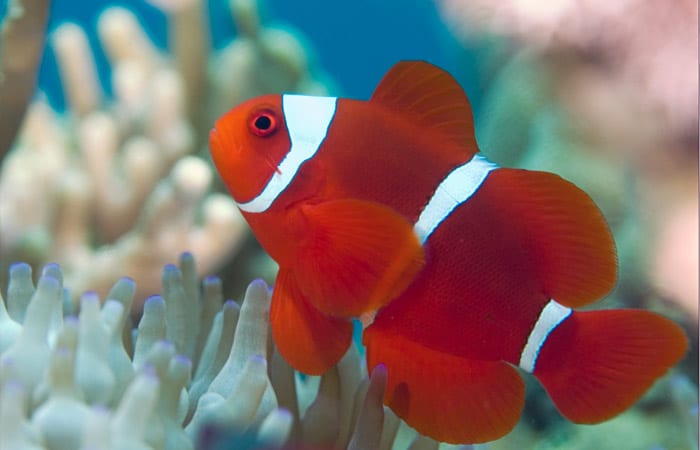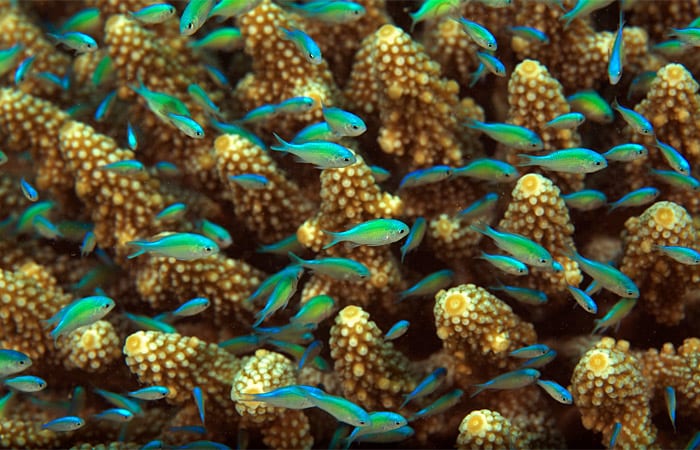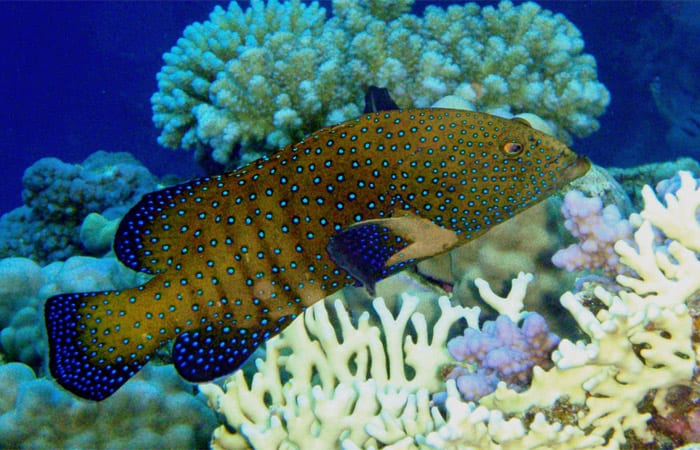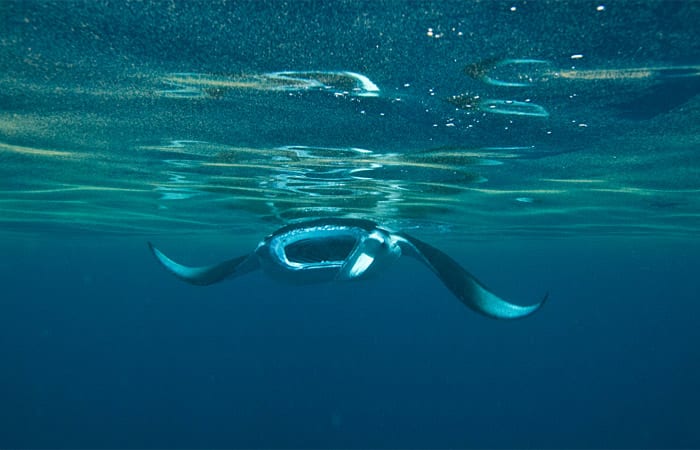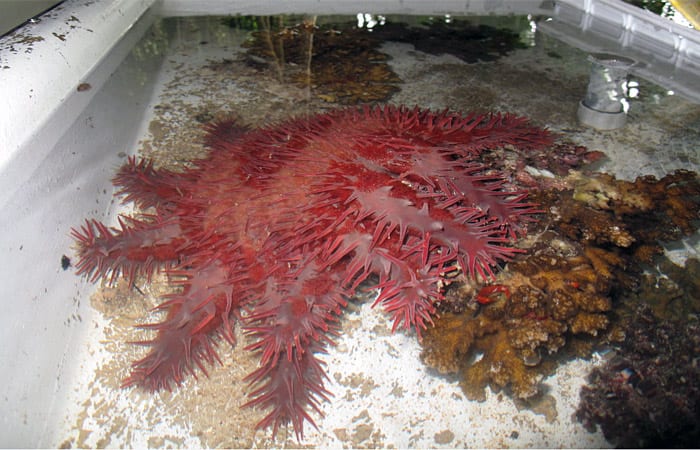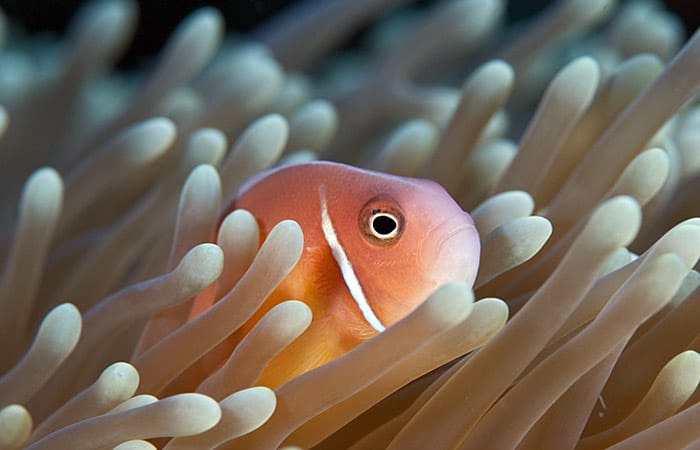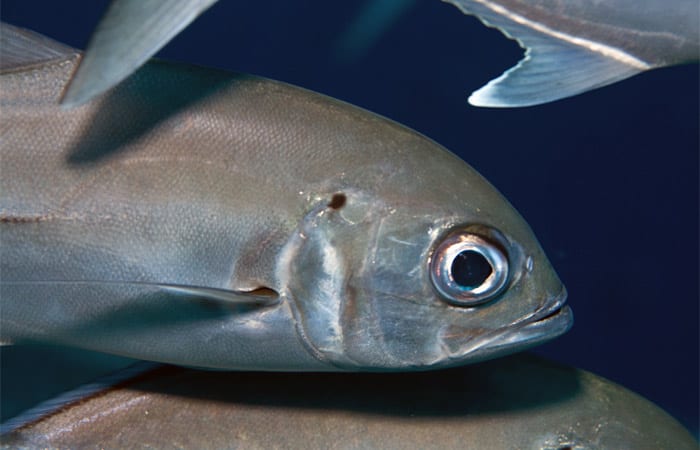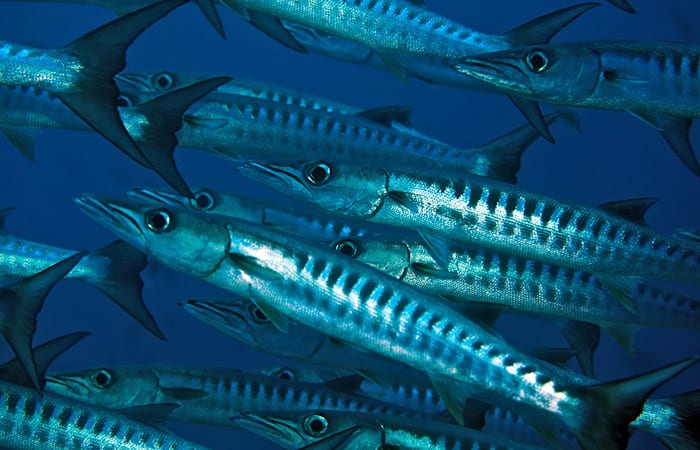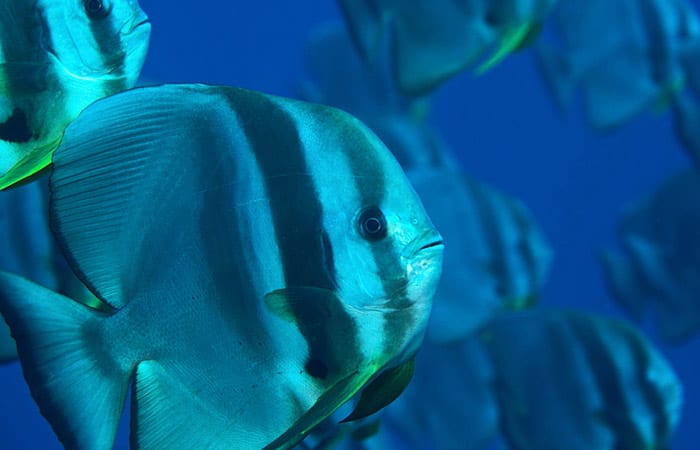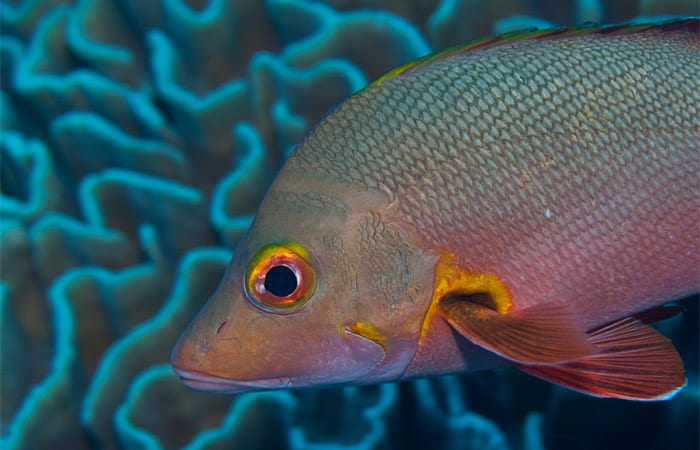- Spine-cheek anemonefish (Premnas biaculeatus)
A spine-cheek anemonefish (Premnas biaculeatus), or maroon clownfish, swims along a coral reef in Kimbe Bay, Papua New Guinea (Photo by Simon Thorrold, Woods Hole Oceanographic Institution) - Bluegreen chromis (Chromis viridis)
A school of colorful, bluegreen chromis (Chromis viridis) seek shelter in a coral colony in the Farasan Banks, Red Sea. (Photo by Simon Thorrold, Woods Hole Oceanographic Institution) - Peacock grouper (Cephalopholus argus)
A peacock grouper (Cephalopholus argus) swims along the Farasan Banks in June 2009. (Photo by Simon Thorrold, Woods Hole Oceanographic Institution) - Manta ray (Manta birostris)
A manta ray (Manta birostris) opens its mouth wide to engulf zooplankton and other tidbits in the water. The dark marks visible inside the mouth are its gill slits. Manta rays, which are filter feeders and have vestigial teeth, often appear to be curious about human divers. WHOI biologist Simon Thorrold photographed the ray while studying fish on and around coral reefs in the Red Sea in May, 2010, as part of WHOI’s research collaboration with King Abdullah University of Science and Technology. (Photo by Simon Thorrold, Woods Hole Oceanographic Institution) - Crown-of-thorns starfish (Acanthaster)
Acanthaster (the crown-of-thorns starfish) preys on coral polyps and, when numerous, can damage coral reefs. WHOI biologist Ann Tarrant collected this specimen at the Liquid Jungle Lab (LJL) in Panama and placed it in a tank to observe the behavior of small red crabs (visible on the coral) in its presence. (Photo by Jesus Pineda, Woods Hole Oceanographic Institution) - Pink anemonefish (Amphiprion perideraion)
A pink anemonefish (Amphiprion perideraion) looks out from the tentacles of its home, a big anemone in Kimbe Bay, Papua New Guinea, where WHOI fish ecologist Simon Thorrold has a long-term research project to study connections among populations of reef fish. Thorrold tracks the migrations and dispersal of fish, ranging from this small reef-dweller to whale sharks, the largest fish in the sea. (Photo by Simon Thorrold, Woods Hole Oceanographic Institution) - Bigeye trevally (Caranx sexfasciatus)
A bigeye trevally (Caranx sexfasciatus) casts a wary eye on WHOI biologist Simon Thorrold, who photographed this and many other species during a research trip to the coral reefs of Kimbe Bay, Papua New Guinea. During the day, bigeye trevallies, which are usually two to three feet long, typically move slowly in schools of 1,500 or more. At night, they disperse as each fish forages for crustaceans or small fish. Thorrold is leading a long-term study of the movement of fish larvae among different reefs in the bay. (Photo by Simon Thorrold, Woods Hole Oceanographic Institution) - Blackfin barracuda (Sphyraena qenie)
A school of blackfin barracuda (Sphyraena qenie), hovering near a coral reef in Kimbe Bay off New Britain island, Papua New Guinea. This species of barracuda is typically found along the edges of reefs, often remaining motionless in a strong current without any apparent effort. Voracious predators of other fish, barracuda commonly reach 1 meter (3 feet) in length but can grow to double that size. (Photo by Simon Thorrold, Woods Hole Oceanographic Institution) - Teira batfish (Platax teira)
Fish ecologist Simon Thorrold's research on pristine coral reefs in Kimbe Bay, Papua New Guinea yields both scientific results and beautiful images—such as these Teira batfish (which can grow to two feet) streaming past the reef. Thorrold studies dispersal and migration of reef fish using chemical tracers in their ear bones and DNA fingerprinting. His goal is to understand how larval fish journey through the open ocean before finding their adult homes on reefs, and how populations on separate reefs are connected to each other. (Photo by Simon Thorrold, Woods Hole Oceanographic Institution) - Paddletail snapper (Lutjanus gibbus)
The paddletail snapper (Lutjanus gibbus) gets around. Its habitat is reefs, and it can be found in tropical marine waters from the Red Sea, throughout Micronesia, north to Japan and south to Australia. This particular example was spotted by WHOI biologist Simon Thorrold in the coral reefs of Kimbe Bay on the north shore of New Britain, Papua New Guinea. (Photo by Simon Thorrold, Woods Hole Oceanographic Institution)
Image and Visual Licensing
WHOI copyright digital assets (stills and video) on this website can be licensed for non-commercial use upon request and approval. Please submit your request via our Media Request Form.
For assistance or accessibility accommodations, call (508) 289-2647.
